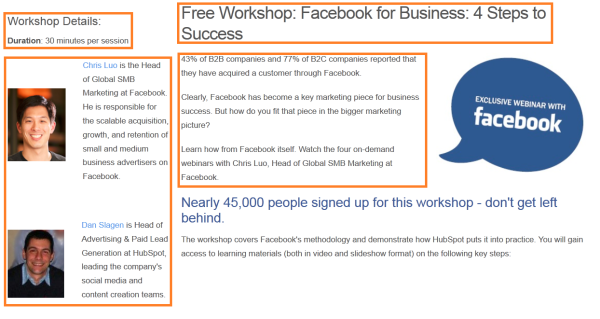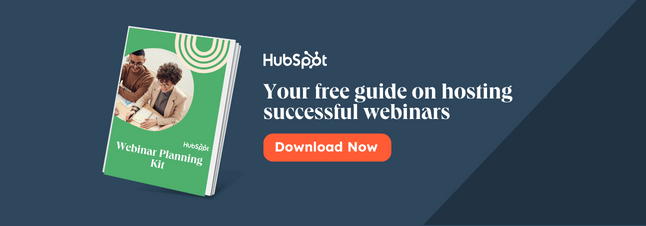So, you’ve decided to host a webinar. Great idea! Webinars are fantastic for generating high quality leads, and they can also help you build stronger relationships with your current customers.
But hosting a successful webinar? That's a whole different ball game. If you want to host a kick-butt webinar, there are a ton of moving parts that you'll have to prepare for ... not to mention a host of things that could go wrong along the way.
Sound stressful? It can be, but you can alleviate a lot of that stress with advance preparation, and a checklist of sorts that will help you ensure you don't make any of the mistakes that make for a kind of, well, crappy webinar experience for attendees. So here you go, all of the things you absolutely should not do when preparing for and hosting a webinar. Unless, of course, you want to scare away leads and customer. Yeah, we didn't think so.
1) Pick a Lousy Topic
People won’t take time out of their day to listen to people drone on about a topic that stinks. If you choose a bland subject that your target audience has heard or read about hundreds of times, they’re not going to spend time attending your webinar. Remember, a webinar is a serious time commitment (which is why it's a great indicator of high quality leads). But if they could just as easily learn about your topic via a blog post that takes five minutes to read, why would they dedicate 30, 45, or 60 minutes to listening to an explanation?
When thinking about a webinar topic, try to think of something that's best explained as a presentation -- with the help of both visuals, and verbal explanation. Also consider the point of the webinar -- are you trying to attract net new leads, or nurture existing leads? Your topic will have to align with the point in the sales cycle you're targeting; remember, existing leads might be able to handle something a little meatier and product- or service-specific than someone who is just starting their research.
2) Host Your Webinar at an Inconvenient Time
Hosting your webinar at unsuitable time is a major no-no, but a detail that's so easily overlooked. Make the date and time convenient for the majority of your audience, keeping in mind that will differ based on who you are targeting. That means, for instance, that B2B marketers should consider when the slowest working hours are for their audience and probably want to host on a weekday, not a weekend. I mean, no matter how awesome your webinar, people aren't too keen on waking up at 7 a.m. on a Sunday to hear you talk about long tail keyword research techniques, know what I mean? (Although if you'd like to hear us talk about using Facebook for Business, like, right now, check out our on demand webinar with Facebook's own Chris Luo. We'd love to have you anytime. Even 7 a.m. on a Sunday.)
It's also important to keep time zones in mind when picking your webinar time. If you're targeting an international, or even a nationwide audience, figure out the time when the most people will be able to attend your event -- remember, East Coasters, your lunchtime is our West Coast brethren's coffee hour.
If you want to pick a specific time that works well for your audience and you're not sure how to figure that out, include a field in your signup form that asks people to confirm the best time slot, or even send a post-webinar feedback survey to see what days and times would work best for them in the future.
3) Choose an Unstable Webinar Platform
If people are encountering a ton of technical errors, it'll distract from the effectiveness of your webinar. Choosing a reliable webinar platform is well worth your time to research, especially if you're expecting a big turnout. If you’re looking for a free platform and don't need a ton of bells and whistles, Livestream and AnyMeeting.com offer free versions of their product ... just remember they won't offer as much as paid versions. Other affordable and reliable systems are GoToWebinar and WebEx, especially for larger webinars.
There's a chance that even with appropriate platform, you may run into a technical glitch. No technology is flawless, and hey, things happen. Anticipate problems that might occur and have some safeguards in case you run into a worst case scenario. Consider having the following handy:
- Backup Computer - Log in on two computers, this way, if the primary machine crashes or the session window is accidentally closed out, the presenter can continue from the second computer.
- Backup Telephone - Dial in on two telephones so if one disconnects, the presenter can continue from the second line without interruption.
- Slide Printout - Make sure there is a printout of the slide presentation so if your screen cuts out or a program starts updating unexpectedly, the presenter can continue talking off of the printed slides.
- Separate Networks - Moderators and presenters should be on separate networks so if one system drops, the other can continue to advance the slides for the audience and keep attendees up to date on any technical glitches occurring.
4) Don’t Promote Your Event
Don't let all your hard content creation work go to waste by hosting a webinar that no one shows up to. To fill "seats," you need to get your promotion on. Leverage all your marketing channels to get the word out there.
- Email Marketing - Send an email invitation to those on your email list that would be interested in the topic about which you're presenting -- in other words, do some segmentation, not a full-fledged database blast.
- Social Media - Let everyone know about your upcoming webinar via your social channels, particularly Facebook, LinkedIn, and Twitter. Do this more than once -- social media moves fast, and it behooves you to remind your audience a handful of times. Be sure to include a link to the landing page on which they can register for the webinar in all of your updates; if you also have a compelling visualization or statistic from the webinar, even better!

- Website - Promote your webinar on your website by including calls-to-action (CTAs) on prominent, relevant pages on your website, particularly the ones trafficked by the audience you're looking to attract as attendees.
- Blog - Write a few blog articles that are related to the webinar topic, and include CTAs leading to your webinar landing page for those who want to learn more and register. A blog is a great place to tee up attendees by teaching them some basic principles about which you'll go into more depth on your webinar.
- Paid Media- If you have a budget, a little paid media can always add to your organic efforts. Try running a PPC ad for specific terms that relate to your webinar.
5) Create a Confusing Landing Page
People shouldn’t be lost when they arrive on your landing page to register for your webinar. If they click on a CTA about attending an upcoming webinar and they’re directed to a page that's unorganized or unclear, you better believe your conversion rates will seriously suffer. Make sure your landing page clearly states who the webinar presenter will be, what the topic is, when it will be hosted, and what people will learn from attending it. Here's an example of the information a landing page should include alongside the form, from our webinar Facebook for Business: 4 Steps to Success:

This page addresses the questions any webinar attendee will want to know: how long the workshop takes, who is hosting it, what the webinar actually is, and why it will be valuable. Since this webinar is on-demand, there's not date and time listed ... but you can bet your buttons it was there when the webinar was being recorded live!
6) Don’t Practice Your Webinar Beforehand
Pshh, who needs practice?
Oh wait, everyone. It doesn’t matter if you’re a public speaking expert -- everyone needs to practice before they host a live webinar, especially if they're presenting with a colleague or co-marketing partner. Practice will ensure you know the information like the back of your hand, you have your phrasing and transitions down, and you're familiar with the webinar platform you're using. In order to make sure your webinar will be a success, do a dry run a day or two before so you have time to correct any issues that may arise.
7) Don't Remind People About Your Webinar
They have nothing else going on, they'll totally remember on their own. Truth is, if you do early promotions for your webinar, some people will sign up and forget its approaching. I know, you're super organized and put everything on your calendar immediately, but we're not all that on the ball ;-)
Send an email reminder at least one week before the webinar, reminding registrants when and where the webinar is and even including some teaser content to keep them excited about the event. One day before, and the day of your webinar, send out a very short email that reminds people when the event is. Be sure to include a direct link to the webinar on the day of the event so it's easy for them to log in, and write up a short reminder of the webinar's topic and the value it will provide.
8) Start Your Webinar Late. Or Early.
If you tell everyone you’re going to start the webinar at 1PM EST, make sure it starts no later, and no earlier, than 1 PM EST. This is another one of those "duh" things that a lot of people screw up. Look, if it starts at 1:02, people aren't going to lose their minds, but being extremely prompt is a sign that you respect other people's busy schedules. If you are running into unpreventable technical errors that are forcing you to start a little behind schedule, be sure your webinar moderator is keeping attendees completely in-the-know about what's going on, and when your anticipated start time will be.
9) Write an Unedited Novel on Your Slide Deck
Your webinar has a presenter for a reason -- so attendees don't have to read too much stuff, and a real live human can explain it to them instead! But when webinar slides are chock full of text, attendees spend all their time reading the text instead of listening and learning.
Instead, select images and a few words that are a good complement to what you're saying, and are easy to digest in just a couple seconds. Usually, using just a few images, simple charts, and a few bullet points are best for slides. Here's a good example from one of our webinars. These images act as props in the webinar, so the presenter can speak about a concept that these images help support.

Finally, have someone else take a look at your work to double check for mistakes, or anything that isn't totally clear. While stories and slides might make sense to you (heck, you created them, they better!), an outsider can help ground you in reality and let you know if something could be even more clear.
10) Don’t Interact With Your Audience
A big benefit of attending (and hosting) webinars is the ability to have presenters and audience members interact. Be sure to support conversation between attendees and presenters, and provide time to answer any questions attendees may have. You might consider:
- Sending out polls and quizzes during and after the webinar
- Using your webinar platform's chat function to field questions during the webinar
- Keeping the conversation going on social media by using a webinar hashtag
- Writing a blog post after the event covering the main webinar points, and answering the most commonly asked questions within the post
Before the webinar begins, you should also prepare answers to any questions you can anticipate, and have a list of references and links. This way, you can quickly answer questions when they arise during the live presentation.
11) Don’t Say Thank You
As Stephanie Tanner would say, "How rude!" Saying thank you for signing up, and for attending is incredibly important. After all, these people took significant time out of their lives to attend your webinar; showing some gratitude is definitely called for.

And the bonus? This also gives you some real estate to provide more detailed information about your webinar, or provide other reconversion opportunities.
Hosting a webinar can seem daunting at first. But, if you avoid these 13 mistakes and you’re willing to put some time into it, your webinar will totally and unequivocally rock. And if you want to see some webinar examples, check out HubSpot's on demand webinars for a little inspiration.














![How to Write a Webinar Script [+ Template]](https://www.hubspot.com/hubfs/181_Write-a-Webinar-Script.png)